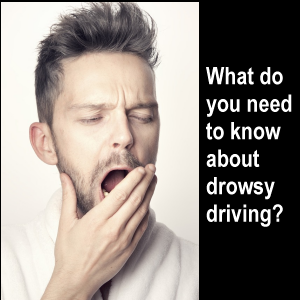What do you need to know about drowsy driving — especially for professional truck drivers — and how dangerous is it?
Definition of Drowsy Driving
 The word drowsy has been defined as “Dull with sleepiness; sluggish.”
The word drowsy has been defined as “Dull with sleepiness; sluggish.”
So when one is engaging in “drowsy driving,” one may be tired, sleepy, or fatigued.
This is a dangerous combination because one’s actions behind the wheel of a vehicle can affect not only the driver, but other members of the motoring public as well.
Statistics Associated with Driving While Drowsy
A September 13, 2022, article states, “Each year, drowsy driving accounts for about 100,000 crashes, 71,000 injuries and 1,550 fatalities, according to the National Safety Council (NSC).”
Furthermore, “a study from the AAA Foundation for Traffic Safety found that drowsiness was a contributing factor in up to 9.5 percent of all crashes and 10.8 percent of crashes that included airbag deployment, injury or significant property damage.”
Results of Drowsy Driving
According to that same article, the results of riving or operating a motor vehicle while one is tired or feeling fatigued (or sleepy) can result in:
- Inability to focus;
- Delayed reaction times;
- Poor judgment;
- Inability to judge distances and speeds; and
- Falling asleep.
What’s one of the reasons why professional truck drivers are required to take sleep breaks (sleeper berth time) every day?
“When you are awake for more than 18 hours, the effect on your body is the same as if you had a BAC of 0.05 percent. According to the CDC, after being awake for 24 hours, it’s similar to having a BAC of 0.10 percent, which far exceeds the legal limit in all states. Considering the legal blood alcohol content (BAC) limit is 0.08 percent, drowsy driving is similar to drunk driving.”
This resource says, “Drowsiness behind the wheel is responsible for over 1,500 deaths each year.”
According to this resource: “According to the National Highway Traffic Safety Administration (NHTSA), in 2017 drowsy driving led to at least 91,000 crashes, resulting in roughly 50,000 injuries and 800 deaths3.”
Signs of Drowsy Driving
- Drifting from one’s lane of travel;
- Rolling over the rumble strip at the sides of one’s lane;
- Yawning, blinking or rubbing one’s eyes frequently;
- Not remembering clearly the last few miles one has driven;
- Missing one’s intended exit;
- Being irritable and/or restless;
- Having disconnected thoughts or daydreaming; and/or
- If talking, not being coherent or not finishing one’s sentences.
Is Highway Hypnosis the Same Thing?
That being said, this resource says, “Highway hypnosis is not necessarily correlated with drowsiness, which can significantly inhibit your reaction time and even lead to lost moments when you’re not fully conscious at the wheel.”
Then they give a definition:
“…highway hypnosis is an example of automaticity, or our ability to do things we’ve done countless times before with little to no input from our conscious mind.”
Who is Most at Risk of Drowsy Driving?
Various websites list who is most at risk of drowsy driving, but in an nutshell, here’s an overview:
- Shift workers;
- Commercial truck drivers;
- Those with sleep disorders;
- Young men.
- Inexperienced drivers (including teens).
Common Causes of Drowsy Driving
- Sleep deprivation;
- Sleep disorders (including, but not limited to sleep apnea);
- Drinking alcohol;
- Taking medication;
- Time of day:
- night-time hours: (midnight – 8 a.m.); and
- mid-afternoon (1 p.m. – 3 p.m.)
What Does NOT Solve this Problem
We do NOT recommend trying to trick your body to keep going through any of these means of external stimulation:
- Blowing cold air on your face;
- Pinching yourself;
- Rocking back and forth or doing physical exercises in the driver’s seat;
- Turning up the radio, CD player, etc.;
- Talking with someone in one’s truck or on the CB radio (or even talking to yourself);
- Taking, drinking, or eating anything with a high amount of caffeine; or
- Engaging in other forms of distracted driving (such as eating, smoking, etc.).
The best way to avoid drowsy driving is to make sure that one has had enough good, deep, restorative sleep.
You may wish to read this article on our website:
How to Sleep Better as a Professional Truck Driver.
Return from Drowsy Driving to our Health and Wellness page or to our Truck Drivers Money Saving Tips home page.









